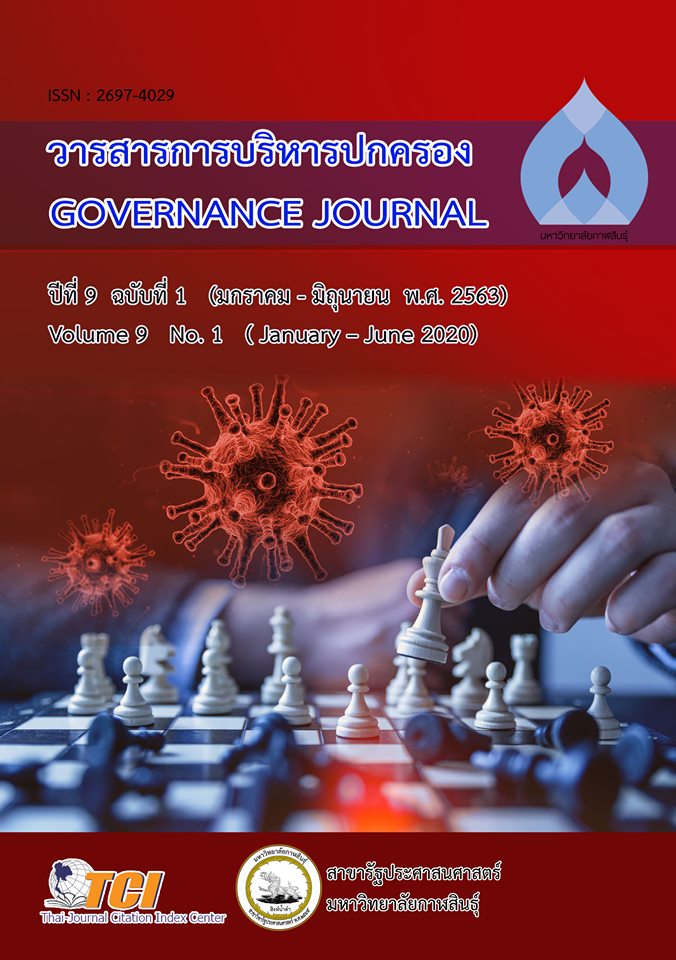ความมั่นคงของอาเซียนกับการจัดการความสัมพันธ์ประเทศภายนอก
DOI:
https://doi.org/10.14456/gjl.2020.9คำสำคัญ:
อาเซียน, ความมั่นคง, เออาร์เอฟบทคัดย่อ
งานวิจัยชิ้นนี้ มีวัตุประสงค์ในการศึกษาพัฒนาการและวิธีการจัดการความสัมพันธ์ด้านความมั่นคงของอาเซียนกับประเทศภายนอก โดยมีข้อเสนอว่าอาเซียนมีการปรับตัวอยู่ตลอดเวลาในบริบทระหว่างประเทศทั้งในช่วงสงครามเย็นและหลังสงครามเย็น ใช้การวิจัยเอกสาร ผลการศึกษาพบว่า การจัดการความสัมพันธ์ด้านความมั่นคงของอาเซียนกับประเทศภายนอกช่วงสงครามเย็น แสดงให้เห็นถึงการที่อาเซียนพยายามใช้ยุทธศาสตร์ประกันความมั่นคง และการสร้างความเป็นศูนย์กลางในสถานการณ์ระหว่างประเทศที่มีการแข่งขันกันอย่างรุนแรงของประเทศมหาอำนาจตลอดระยะเวลาของสงครามเย็น ทั้งนี้ เมื่อสถานการณ์ได้เปลี่ยนแปลงไป อาเซียนได้ร่วมมือกับมหาอำนาจและนานาชาติตลอดจนองค์การระหว่างประเทศ เพื่อแสวงหาการสนับสนุนแก่กลุ่มตนมาโดยตลอด การปรับตัวของอาเซียนและการจัดการกับความสัมพันธ์กับประเทศภายนอกในช่วงเวลาดังกล่าวนี้ แสดงให้เห็นอย่างเป็นรูปธรรมในช่วง 3 ระยะเวลา คือ 1) การสถาปนาปฏิญญาว่าด้วยเขตแห่งสันติภาพ เสรีภาพและความเป็นกลาง ในปี 1971 เพื่อปรับตัวจากความเปลี่ยนแปลงของนโยบายต่างประเทศสหรัฐฯ ต่อสงครามเวียดนามในสมัยประธานธิบดีนิกสัน 2) การประชุมสุดยอดอาเซียนครั้งแรกในเดือนกุมภาพันธ์ ปี 1976 เพื่อ “รับมือ” กับสถานการณ์ความเปลี่ยนแปลงในอินโดจีน และ 3) การเข้าเป็นศูนย์กลางในกระบวนการแก้ไขปัญหากัมพูชาในช่วงทศวรรษ 1980 โดยสามารถโน้มน้าวให้ทั้งสหรัฐฯ และจีน ให้ความร่วมมือกับตน ต่อมาในช่วงหลังสงครามเย็น อาเซียนพยายามใช้ยุทธศาสตร์การสร้างความเป็นแกนกลางผ่านสถาบันด้านความมั่นคงของตนเอง คือ การประชุมอาเซียนว่าด้วยความร่วมมือด้านการเมืองและความมั่นคงในภูมิภาคเอเชีย-แปซิฟิก เพื่อโน้มน้าวให้มหาอำนาจในภูมิภาคใช้อาเซียนเป็นศูนย์กลางในการเจราจา
Downloads
เอกสารอ้างอิง
กระทรวงการต่างประเทศ. (2558). สนธิสัญญามิตรภาพและความร่วมมือในเอเชียตะวันออกเฉียงใต้. (ออนไลน์) สืบค้นจาก http://www.mfa.go.th/asean/th/other /2397 (เข้าถึงเมื่อ 23 มกราคม 2562)
กระทรวงการต่างประเทศ. (2559). อาเซียน 2025: มุ่งหน้าไปด้วยกัน. กรุงเทพฯ: เพจเมคเกอร์.
จุลชีพ ชินวรรโณ. (2529). ชนวนสงคราม: ไทย จีน อินโดจีน. กรุงเทพ: ดอกหญ้า.
ทิพพร ศรีจันทร์สุข. (2536). นโยบายต่างประเทศของสาธารณรัฐประชาชนจีนต่อกัมพูชาระหว่างปี 1979-1989. (วิทยานิพนธ์รัฐศาสตรมหาบัณฑิต). กรุงเทพฯ: มหาวิทยาลัยธรรมศาสตร์.
วิบูลย์พงศ์ พูนประสิทธิ์. (2526). นโยบายต่างประเทศของสหรัฐอเมริกาต่อเอเชียอาคเนย์. รัฐศาสตร์สาร, 9(3): 41-55.
สมพงศ์ ชูมาก. (2527). ความพยายามของนานาประเทศในการแก้ไขวิกฤตการณ์กัมพูชา. กรุงเทพฯ: โครงการเผยแพร่ผลงานวิจัย ฝ่ายวิจัย จุฬาลงกรณ์มหาวิทยาลัย.
Acharya, A. (2014). Constructing a security community in Southeast Asia: ASEAN and the problem of regional order. Abingdon, Oxon: Routledge.
Alagappa, M. (1993). Regionalism and the quest for security: asean and the cambodian conflict. Australian Journal of International Affairs, 47(2): 189-209.
ASEAN Regional Forum. (n.d.). Chairman Statement of the 1st Meeting of ASEAN Regional Forum. (Online) Retrieved from http://aseanregionalforum.asean.org/wp-content/uploads/2019/01/ Chairmans-Statement-of-the-1st-ARF.pdf (Accessed 17January 2019)
Association of Southeast Asia Nations. (1988). ASEAN Documents Series 1967-1988 3rd. Jakarta: ASEAN Secretariat.
Ba, A. (2009). (Re) Negotiating East and Southeast Asia Region, Regionalism, and the Association of Southeast Asian Nations. Stanford, Calif: Stanford University Press.
Caballero-Anthony, M. (2005). Regional security in Southeast Asia: Beyond the ASEAN way. Singapore: Institute of Southeast Asian Studies.
Draguhn, W. (1983). The Indochina conflict and the positions of the countries involved. Contemporary Southeast Asia, 5(1): 100-118.
Emmers, R. (2003). Cooperative security and the balance of power in ASEAN and the ARF. London: RoutledgeCurzon.
Frost, F. (1990). Introduction: ASEAN since 1967. In A. Broinowski (ed.), ASEAN into the 1990s, (pp.12-30). Basingstoke, Hants: Macmillan.
Goh, E and Acharya, A. (2007). The ASEAN Regional Forum and security regionalism: comparing Chinese and American positions. In Melissa Curley and, Nicholas Thomas (eds.), Advancing East Asian Regionalism (pp. 116-135). Abingdon, Oxon: Routledge.
Hanggi, H. (1991). ASEAN and the ZOPFAN concept. Singapore: ISEAS.
He, K. (2007). Institutionalizing security: institutional realism and multilateral institutions in Southeast Asia. (Doctoral dissertation). Arizona State University.
He, K. (2008). Institutional balancing and international relations theory: Economic interdependence and balance of power strategies in Southeast Asia. European Journal of International Relations, 14(3): 489-518.
Hoon, K. (1979). Recent development in China-ASEAN relations. Southeast Asian Affairs: 63-78.
Hyland, W. (1981). U.S.-Soviet relations: the long road back. Foreign Affairs, 60(3): 541-562.
Katsumata, H. (2006). Establishment of the ASEAN Regional Forum: constructing a ‘talking shop’or a ‘norm brewery’?. The Pacific Review, 19(2): 181-198.
keling, M. (2011). The Development of ASEAN from Historical Approach. Asian Social Science, 7(7): 169-189.
Khong Y, F. (1997). Making Bricks without Straw in the Asia-Pacific? The Pacific Review, 10(2): 289–300.
Khong Y, F. (2004). Coping with Strategic Uncertainty: Institutions and Soft Balancing in ASEAN’s Post-Cold War Strategy. In Peter Katzenstein, Allen Carlson, and J. J Suh (eds.), Rethinking Security in East Asia (pp. 172-208). Stanford, Calif: Stanford University Press.
Khong Y, F. and Nesadurai, H. (2007). Hanging Together, Institutional Design and Cooperation in Southeast Asia: The Cases of AFTA and the ARF. In Amitav Acharya and Alistair Iain Johnstone (eds.), Crafting Cooperation: Regional International Institutions in Global Politics (pp. 32-82). New York: Cambridge University Press.
Klintworth, G. (1989). China’s Indochina policy. Journal of Northeast Asian Studies, 8(3): 30-45.
Koga, K. (2014). Institutional transformation of ASEAN: ZOPFAN, TAC, and the Bali Concord I in 1968-1976. The Pacific Review, 27(5): 729-753.
Koga, K. (2018). The Concept of “Hedging” Revisited: The Case of Japan's Foreign Policy Strategy in East Asia's Power Shift. International Studies Review, 20: 633-660.
Kuik, C. C. (2016). Institutionalization of security cooperation in East Asia. In Alice D. Ba, Cheng-Chwee Kuik and Sueo Sudo (eds.), Institutionalizing East Asia: mapping and reconfiguring regional cooperation (pp. 105-130). New York: Routledge.
Kusuma-Atmadja, M. (1990). Some Thoughts on ASEAN Security Co-operation: An Indonesian Perspective. Contemporary Southeast Asia, 12(3): 161-171.
Leifer, M. (1996). The ASEAN Regional Forum: Extending ASEAN's Model of Regional Security, Adelphi Paper 302. Oxford: Oxford University Press.
Murphy, A. (2008). United States relations with Southeast Asia: The legacy of policy changes. In Ann Marie Murphy and Bridget Welsh (eds.), Legacy of Engagement in Southeast Asia (pp. 249-279). Singapore: Institute of Southeast Asian Studies.
Narine, S. (1998). ASEAN and the management of region security. Pacific Affairs, 71(2): 195-214.
Narine, S. (2018). The new ASEAN in Asia pacific and beyond. Boulder, Colorado: Lynne Rienner.
“Puny counter-revolution alliance”. (1967). Peking Review, 10(3): 40-44.
Saull, R. (2008). American foreign policy during the Cold War. In M. Cox and D. Stokes (eds.), US foreign policy (pp.64-82). New York: Oxford University Press.
Schellhorn, K., M. (1992). Asia after the end of cold war. Southeast Asian Affairs: 58-70.
Severino, R. (2008). ASEAN (No. 10). Singapore: Institute of Southeast Asian Studies.
Sodhy, P. (1989). A survey of U.S. post-Vietnam policy and the Kampuchean dilemma, 1975-89: A Southeast Asian view. Contemporary Southeast Asia, 11(3): 289-319.
Soon, L. (1982). ASEAN and the Cambodia problem. Asian Survey, 22(6): 545-561.
“Tun Rasak ‘s Proposal for neutralization of Southeast Asia”. (1971). Asian Almanac, 9: 4469.
United Nations. (2018). UN Resolution 34/22. (Online) Retrieved from http://www.un.org/en/ga/ search/ view_doc.asp?symbol=A/RES/34/22 (Accessed 17 January 2019)
Waltz, K. (1979). Theory of International Relations. Reading, Mass: Addison-Wesley.
Yuzawa, T. (2012). Challenges and prospects. Routledge Handbook of Asian Regionalism. In M. Beeson and R. Stubbs (Eds.), Routledge handbook of Asian regionalism (pp. 338-349). London: Routledge.
Translated Thai References
Chinwanno, C. (1986). The Origin of War: Thai China Indochina. Bangkok: Dogya.
Chumak, S. (1984). International Cooperation in Kampuchea Crisis Problem Solving. Bangkok: Disseminating Research, Chulalongkorn University.
Minister of Foreign Affairs. (2015). Treaty of Amity and Cooperation in Southeast Asia. (Online) Retrieved from http://www.mfa.go.th/asean/th/other /2397 (Accessed 23 January 2019)
Minister of Foreign Affairs. (2016). ASEAN 2025: Forging Ahead Together. Bangkok: Pagemaker.
Phunprasit, W. (1983). U.S. foreign Policy to Southeast Asia. Journal of Political Science, 9(3): 41-55.
Sichansuk, T. (1993). Chinese foreign Policy to Kampuchea, 1979 - 1989. (Master of Political Science). Bangkok: Thammasat University.
ดาวน์โหลด
เผยแพร่แล้ว
รูปแบบการอ้างอิง
ฉบับ
ประเภทบทความ
สัญญาอนุญาต

อนุญาตภายใต้เงื่อนไข Creative Commons Attribution-NonCommercial-NoDerivatives 4.0 International License.








